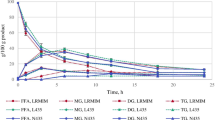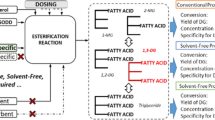Abstract
Tocopherols have been purified from deodorizer distillate produced in the final deodorization step of vegetable oil refining by a process including molecular distillation. Deodorizer distillate contains mainly tocopherols, sterols, and free fatty acids (FFA); the presence of sterols hinders tocopherol purification in good yield. We found that Candida rugosa lipase recognized sterols as substrates but not tocopherols, and that esterification of sterols with FFA could be effected with negligible influence of water content. Enzymatic esterification of sterols with FFA was thus used as a step in tocopherol purification. High boiling point substances including steryl esters were removed from soybean oil deodorizer distillate by distillation, and the resulting distillate (soybean oil deodorizer distillate tocopherol concentrate; SODDTC) was used as a starting material for tocopherol purification. Several factors affecting esterification of sterols were investigated, and the reaction conditions were determined as follows: A mixture of SODDTC and water (4∶1, w/w) was stirred at 35°C for 24 h with 200 U of Candida lipase per 1 g of the reaction mixture. Under these conditions, approximately 80% of sterols was esterified, but tocopherols were not esterified. After the reaction, tocopherols and FFA were recovered as a distillate by molecular distillation of the oil layer. To enhance further removal of the remaining sterols, the lipase-catalyzed reaction was repeated on the distillate under the same reaction conditions. As a result, more than 95% of the sterols was esterified in total. The resulting reaction mixture was fractionated to four distillates and one residue. The main distillate fraction contained 65 wt% tocopherols with low contents of FFA and sterols. In addition, the residue fraction contained high-purity steryl esters. Because the process presented in this study includes only organic solvent-free enzymatic reaction and molecular distillation, it is feasible as a new industrial purification method of tocopherols.
Similar content being viewed by others
References
Hoshino, T., T. Yamane, and S. Shimizu, Selective Hydrolysis of Fish Oil by Lipase to Concentrate n−3 Polyunsaturated Fatty Acids, Agric. Biol. Chem. 54:1459–1467 (1990).
Syed Rahmatullah, M.S.K., V.K.S. Shukla, and K.D. Mukherjee, Enrichment of γ-Linolenic Acid from Evening Primrose Oil and Borage Oil via Lipase-Catalyzed Hydrolysis, J. Am. Oil Chem. Soc. 71:569–573 (1994).
Shimada, Y., N. Fukushima, H. Fujita, Y. Honda, A. Sugihara, and Y. Tominaga, Selective Hydrolysis of Borage Oil with Candida rugosa Lipase: Two Factors Affecting the Reaction, ——Ibid. 75:1581–1586 (1998).
Foglia, T.A., and P.E. Sonnet, Fatty Acid Selectivity of Lipases: γ-Linolenic Acid from Borage Oil, ——Ibid. 72:417–420 (1995).
Shimada, Y., N. Sakai, A. Sugihara, H. Fujita, Y. Honda, and Y. Tominaga, Large-Scale Purification of γ-Linolenic Acid by Selective Esterification Using Rhizopus delemar Lipase, ——Ibid. 75:1539–1543 (1998).
Haraldsson, G.G., and B. Kristinsson, Separation of Eicosapentaenoic Acid and Docosahexaenoic Acid in Fish Oil by Kinetic Resolution Using Lipase, ——Ibid. 75:1551–1556 (1998).
Shimada, Y., K. Maruyama, A. Sugihara, T. Baba, S. Komemushi, S. Moriyama, and Y. Tominaga, Purification of Ethyl Docosahexaenoate by Selective Alcoholysis of Fatty Acid Ethyl Esters with Immobilized Rhizomucor miehei Lipase, ——Ibid. 75:1565–1571 (1998).
Myojo, K., and Y. Matsufune, Process for Preparing Sterol Fatty Acid with Enzymes, J. Jpn Oil Chem. Soc. (in Japanese) 44:883–896 (1995).
Shimada, Y., Y. Hirota, T. Baba, A. Sugihara, S. Moriyama, Y. Tominaga, and T. Terai, Enzymatic Synthesis of Steryl Esters of Polyunsaturated Fatty Acids, J. Am. Oil Chem. Soc. 76:713–716 (1999).
Sugihara, A., M. Ueshima, Y. Shimada, S. Tsunasawa, and Y. Tominaga, Purification and Characterization of a Novel Thermostable Lipase from Pseudomonas cepacia, J. Biochem. 112:598–603 (1992).
Shimada, Y., K. Maruyama, S. Okazaki, M. Nakamura, A. Sugihara, and Y. Tominaga, Enrichment of Polyunsaturated Fatty Acids with Geotrichum candidum Lipase, J. Am. Oil Chem. Soc. 71:951–954 (1994).
Author information
Authors and Affiliations
Corresponding author
About this article
Cite this article
Shimada, Y., Nakai, S., Suenaga, M. et al. Facile purification of tocopherols from soybean oil deodorizer distillate in high yield using lipase. J Amer Oil Chem Soc 77, 1009–1013 (2000). https://doi.org/10.1007/s11746-000-0160-z
Received:
Accepted:
Issue Date:
DOI: https://doi.org/10.1007/s11746-000-0160-z




